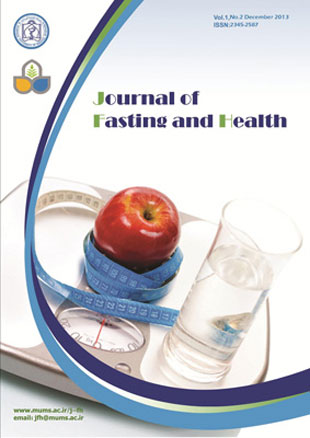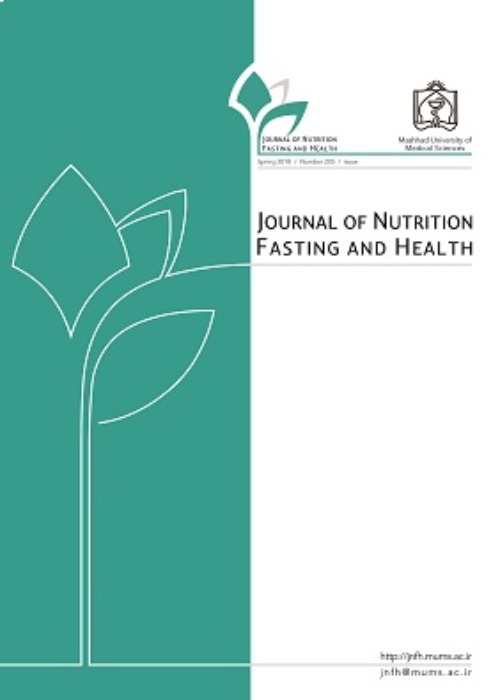فهرست مطالب

Journal of Nutrition, Fasting and Health
Volume:1 Issue: 2, Autumn 2013
- تاریخ انتشار: 1392/07/15
- تعداد عناوین: 7
-
-
Pages 43-45Ramadan is one of the special months for Muslims all over the world. During Ramadan, able‐bodied Muslims are abstained from eating, drinking and even smoking from dawn to sunset. In Malaysia, the duration of fasting are normally around 13 hours at any time of the year as it is located near the equator. The altered food intake timing and long period of fasting do influence on eating behavior of fasting individuals. This is especially on those who do not know the right meals to eat during the time of breakfast. Hence, this issue may favor those intended to organize Ramadan Bazaar along the streets and Ramadan buffets in hotels. The implications of these two phenomena which create an abundant food environment may lead to food wasting, binge eating and overeating. However, this may benefit the country’s economy; the Muslims need to be mindful that Ramadan is a month of moderation. Hence, the food carnivals during Ramadan need to be observed wisely for the benefit of the ritual and in point of view of population health.Keywords: Diet Eating behavior Fasting
-
Pages 46-52IntroductionMuslims fast from dawn to dusk during Ramadan. The effects of prolonged food deprivation on endocrine hormones have been studied in healthy adults but no previous study has investigated this effect on children. This study aimed to evaluate the feasible changes in serum level of thyroxin (T3), tetraiodothyronin (T4), thyroid stimulating hormone (TSH) and body composition in pre-menarche girls.MethodsThis cohort study was performed through Ramadan 2012. We enrolled fifty-eight 9-13years old girls (weight 34.20±7.96 kg, height 142.01±7.76 cm) in two groups from (31 and 27 in fasted and non-fasted groups, respectively) prior to Ramadan until afterwards. Weight and height of the subjects were measured using standard methods, and then Body Mass Index (BMI) was calculated. Body composition was measured using Bio Impedance Analyzer (BIA) method. Serum concentrations of T3, T4 and TSH hormones were measured by Radio Immunoassay (RIA). Paired t-test was used to compare result of each group before and after Ramadan. Independent t-test was used to compare two groups together. Tanner intervention variable was controlled by generalized linear models intervening test. SPSS.11 software was used for data analysis.ResultsRamadan fasting induces a significant decrease in BMI and weight on fasted group (p=0.005, p=0.044, respectively) while a significant increase was observed in non-fasted group (p<0.001). Although, T3 decreased significantly by fasting (p<0.001), it remained in the normal range. Hence, T4 decreased and TSH increased slightly in both groups.ConclusionsAccording to our findings, despite a significant reduction of T3 in fasting group, variation in thyroid hormones level remained in the normal range during Ramadan fasting.Keywords: Islamic Fasting, Puberty, Ramadan, thyroid hormones
-
Pages 53-57IntroductionRamadan Fasting is prescribed by Holy Quran for every able-bodied, adult Muslim and is considered an essential practice for all Muslims including pregnant women. The aim of this study was to determine the effect of Ramadan fasting on neonatal anthropometric measurements during the third trimester of pregnancy.MethodThis is a cross-sectional study, carried out on 300 delivering women in 2013. All participants were divided into fasting (n=150) and non-fasting (n=150) groups. Neonatal anthropometric measurements were compared in both groups. Data were then analyzed using descriptive statistics and t-test in SPSS Ver. 11.5 at a significant level of 5%.ResultsThere were no significant differences between the two groups in the birth weight (p=0.97), head circumference (p=0.09) and height (p=0.12) of the neonates. Also, the prevalence of LBW was similar in fasting and non-fasting groups (p=0.33).ConclusionRamadan fasting in the third trimester of pregnancy has no adverse effects on neonatal anthropometric measurements.Keywords: Fasting, pregnancy, third trimester, neonatal outcomes
-
Pages 58-65Each year, over a billion Muslims fast worldwide during the month of Ramadan. Through this religious practice, not only will one have spiritual growth, but can improve his/her diet, which is of pivotal importance in this month. Conversely, the available evidence regarding the health benefits of Ramadan fasting is scarce and highly contentious. Although Islam exempts patients from fasting, many of them fast conceivably and their clinical condition is prone to deteriorate. This is due to the persistent gap between current expert knowledge and conclusive, strong evidence regarding the pathophysiologic and metabolic alterations by fasting, and the consensus that healthcare professionals should reach, in order to manage various patient groups during this month. In this review, we summarize the results of our initial studies regarding the effects of Ramadan fasting on some clinical conditions including alterations of body composition. We also go through the important clinical results of patients who have had previous history of cardiovascular disease, type 2 diabetes, asthma and renal colic. Our studies have presented some evidence in favor of Ramadan fasting and encourage those with mentioned diseases to consult their physicians and follow medical and scientific recommendations. We attempt to present some relevant evidence clarify future scopes in this area of study, and provide suggestions for future investigations.Keywords: Asthma, body composition, cardiovascular disease, Diabetes, Fasting, Ramadan, renal colic
-
Pages 66-69IntroductionThere are many advantages in breastfeeding of infants. The impact of fasting of breastfeeding mothers during Ramadan, on their exclusively breastfed infants’ growth, is still unclear. The objective of this study is to determine the impact of maternal Ramadan fasting on growth parameters of exclusively breastfed infants.MethodsThis cohort study was conducted on 55 healthy, exclusively breastfed infants, aged 1 to 6 months, during Ramadan and three months after it. 20 infants, whose mothers fasted throughout Ramadan (case group) and 35 infants, whose mothers did not fast (control group), were enrolled in the study. All infants underwent periodic physical examinations, twice in Ramadan and 3 times in the first, second and the third months after Ramadan. The data analyses were done using a repeated measure analysis of variance. Statistical significance was defined as PFindingsThe average age was 3.43±1.38 months in the case group and 2.31±1.45 months in the control group that presence no significant difference between. From the total number of infants, 23 cases (41.8%) were males and the rest were females. All growth parameters increased during the study period (P< 0.05), with the same rate of increase for both groups (P=0.125).ConclusionRamadan fasting by breastfeeding mothers did not adversely affect the growth parameters of exclusively breastfed infants in short-term.Keywords: Ramadan fasting, Exclusive breastfeeding, Infant, Growth parameters
-
Pages 70-78The purpose of this study was to investigate the effect of one-month fasting along with yoga training on the body composition of novice female athletes. Twenty trained women were randomly assigned to experimental (n=10) and control (n=10) groups. The experimental group participated in yoga training classes for 4 weeks, two 60-min sessions per week; the control group did not participate in any regular exercise programs. This study was conducted on two fasting groups in the month of Ramadan, 2012. The study variables including body fat percentage, body mass index (BMI), waist circumference and waist-to-hip ratio (WHR) were measured in three stages: a week before Ramadan, the fifteenth day of Ramadan, and a week after Ramadan. The results showed that BMI in the fasting yoga group decreased; however the changes of BMI in the control group were not significant. Also, subcutaneous fat showed significant reduction in both experimental and control groups, though the changes were more significant in the exercise group; also, the results showed that waist-to-hip ratio significantly changed in the experimental group. As to the results, yoga exercises along with fasting can help overweight people to experience ideal weight loss; also for the athletes who stop exercising in Ramadan, yoga can be used as an alternative to maintain their weight.Keywords: Fasting, yoga training, body composition, female, weight loss
-
Pages 79-84IntroductionThe effect of fluid and food restrictions on biochemical substances relating to the renal and bone function of pregnant women is not well defined. The purpose of this study is to evaluate the effects of fluid and food restriction on the following substances in pregnant fasting women during Ramadan: blood urea nitrogen (BUN), creatinine (Cr), calcium (Ca), phosphorus (P), and alkaline phosphates (ALP).Material And MethodsThirty fasting pregnant women voluntarily participated in this prospective descriptive study. The serum levels of BUN, Cr, P, and ALP were measured at the baseline, and on the 7th, 14th, and 28th days of Ramadan; the measurements were also performed 2 weeks after this month. The statistical significance was defined as P<0.05 and the analyses were performed using SPSS version 11.5.ResultsAs to the results of the present study,the weight and body mass index (BMI) of women didn’t change during the experiment. BUN and Cr increased significantly by the 2nd week of Ramadan; however, no differences were observed between BUN and Cr values at the end of Ramadan and two weeks after it (P> 0.05); also, Cr didn’t change during Ramadan and 2 weeks after it (P> 0.05). Moreover, no differences in P and ALP levels were noticed between the end of Ramadan and two weeks after it (P> 0.05).ConclusionAccording to this study, there is no sufficient evidence regarding the adverse effects of Ramadan fasting on biochemical substances relating to the renal and bone function of pregnant fasting women.Keywords: Ramadan fasting, pregnant woman, biochemical substances


